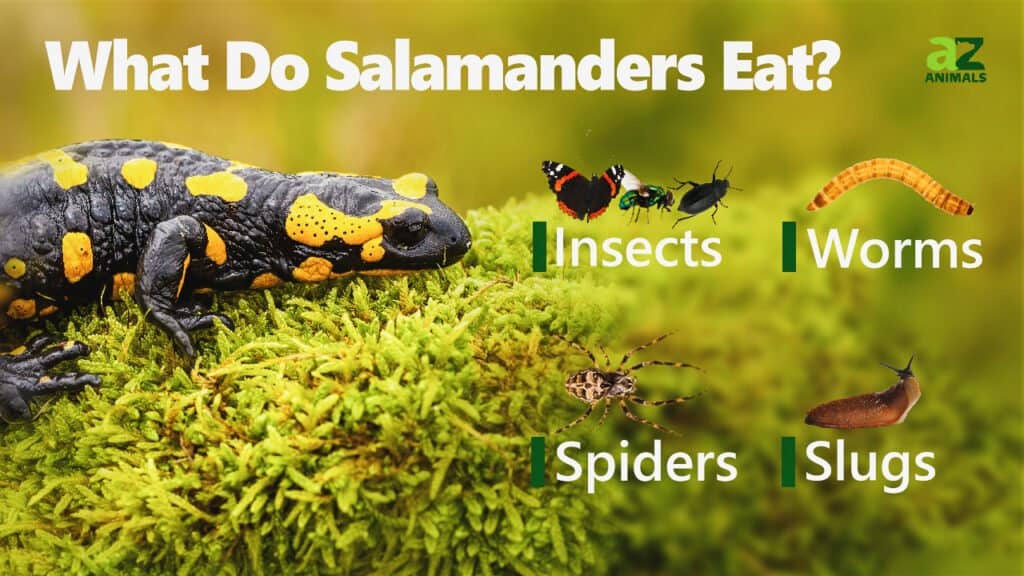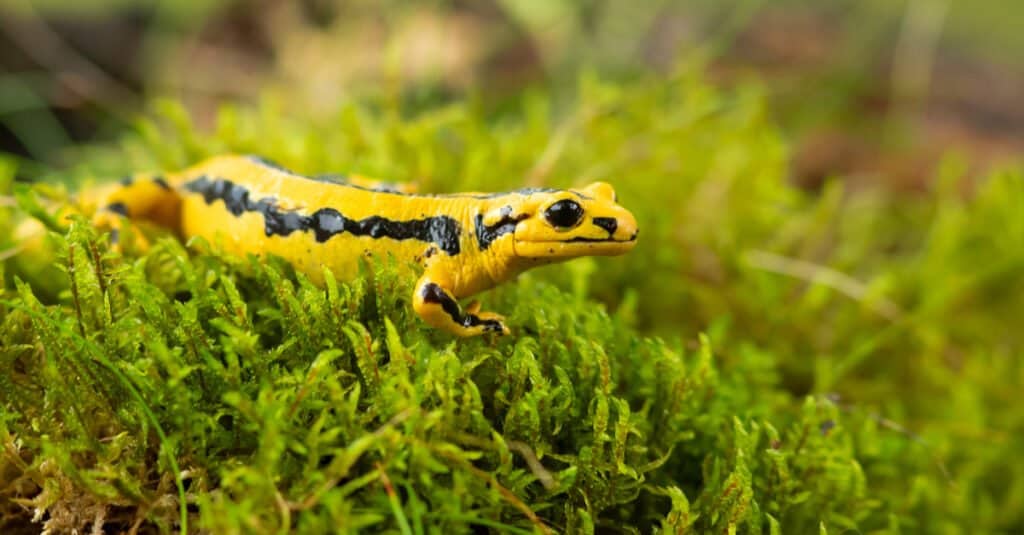Though they may look more like lizards, salamanders are aquatic, semi-aquatic, or terrestrial amphibians who share more in common with frogs than reptiles. Unlike lizards, they have no scales and no claws and their skin is usually very moist. There are well over 600 known species of salamander and they can range in size from ⅝ inches to several feet long, so their diet is naturally very diverse as well. Salamanders are sometimes kept as pets, so food availability is different when they are kept as a pet as opposed to in the wild. Read on to learn more about what salamanders eat.
What Do Salamanders Eat?

Salamanders eat a different diet according to their habitat and whether they are kept as a pet or living in the wild, but the terrestrial varieties are primarily carnivores that will eat almost any living creature they can fit into their mouths. A very few aquatic ones will occasionally eat algae and the like, but this is rare. A salamander’s diet also changes as it grows, mainly owing to what size food it can manage to consume based on its relative size and also because, like amphibians, many salamander species begin in the water and evolve onto the land as they grow up.
What Do Salamanders Eat in Captivity vs in the Wild?
As a baby in the wild, a young salamander nymph will eat things like microorganisms such as daphnia, and then as it grows it will eat larger organisms, such as mosquito larvae or worms, before moving on to adult food. By two months of age, a wild young one will eat the same foods as an adult.
As a pet, a larval salamander should be fed brine shrimp or black worms chopped up finely. Once they are a bit older, they can gradually be introduced to whole black worms and larger worms, as well as larger shrimp species, crayfish, small fish species, and other small insects and animals. They can eat pellets and freeze-dried insects, but it is generally considered best to feed them live food when possible, for better nutrition and also to allow them to “hunt” for insects in their enclosure, much as they would in the wild. Pellets and frozen insects can be used as supplements to the fresh food diet. They also need to take calcium supplements to avoid health problems later on.
What Should Salamanders Not Eat?
They should never be fed fruits or vegetables. Almost all salamanders are carnivores and therefore are not equipped to chew or digest plant matter. Even the omnivorous ones only eat select plant matter such as tiny algae that doesn’t require chewing or much digestion. Captive salamanders probably won’t even try to eat the vegetables or fruits, which would lead to rotten food and a contaminated enclosure, but some of them might be curious enough to try, which could lead to severe stomach issues and possibly even death.
What Salamanders Eat: A List

©Milan Zygmunt/Shutterstock.com
So what exactly do salamanders eat? Below is a list that covers nearly everything that all the various species of salamanders eat.
- Insects including crickets, grasshoppers, flies and aquatic insects.
- Spiders of various species.
- Worms including black worms, tubifex or sludge worms, blood worms and night crawlers.
- Crayfish.
- Shrimp including brine shrimp and other small species.
- Nymphs, larvae and eggs of their own kind and of other animals.
- Small fish such as minnows.
- Amphibians including other salamanders and frogs.
- Microorganisms such as daphnia and cyclops.
- Slugs, isopods, leeches, snails.
- Small mice.
- Algae*
*Only a very few select aquatic species will eat algae. All others are carnivorous.
The North American Newt is an interesting salamander species that can be found all over the wooded areas of the continent. These little salamanders start out their lives in the water. After a year or two, they move out of the water, lose their gills and become bright orange. They live for the next few years roaming around the forest floor. As adults, they travel back to their water source and once again become aquatic. The lifespan of these guys has bee reported to be anywhere from 5 to 30 years!
Up Next…
- Newt vs Salamander: What’s the Difference? Check out this article to find out the difference between a newt and a salamander – if there is one.
- Salamander vs Lizard: What’s the Difference? Many people confuse salamanders for lizards, but they are very different species. Learn more about them here.
- Are Salamanders Poisonous or Dangerous? Why do some salamanders have spots? Are they toxic? Learn more about them here.
The photo featured at the top of this post is © Smarteless/Shutterstock.com
Thank you for reading! Have some feedback for us? Contact the AZ Animals editorial team.






